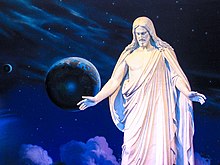Our website is made possible by displaying online advertisements to our visitors.
Please consider supporting us by disabling your ad blocker.
Latter Day Saint movement
This article needs additional citations for verification. (March 2018) |
| Part of a series on |
| Christianity |
|---|
 |

The Latter Day Saint movement (also called the LDS movement, LDS restorationist movement, or Smith–Rigdon movement)[1] is the collection of independent church groups that trace their origins to a Christian Restorationist movement founded by Joseph Smith in the late 1820s.
Collectively, these churches have over 17 million nominal members, including over 17 million belonging to the Church of Jesus Christ of Latter-day Saints (LDS Church),[2][3] 250,000 in Community of Christ,[4] and several other denominations with memberships generally ranging in the thousands of members. The predominant theology of the churches in the movement is Mormonism, which sees itself as restoring again on Earth the early Christian church; their members are most commonly known as Mormons. An additional doctrine of the church allows for prophets to receive and publish modern-day revelations.
A minority of Latter Day Saint adherents, such as members of Community of Christ, have been influenced by Protestant theologies while maintaining certain distinctive beliefs and practices including continuing revelation, an open canon of scripture and building temples. Other groups include the Remnant Church of Jesus Christ of Latter Day Saints, which supports lineal succession of leadership from Smith's descendants, and the more controversial Fundamentalist Church of Jesus Christ of Latter-Day Saints, which defends the practice of polygamy.[5][6][7] One source estimated over 400 denominations have sprung from founder Joseph Smith's original movement.[8]
- ^ Shields, Steven L. (2012). "Proposing an Academic Name for the Movement". Restoration Studies. 13: 47–60. ISBN 9781934901830.
- ^ Noyce, David (April 1, 2023). "Global LDS membership reaches a new high. See how it got a post-COVID boost". Salt Lake Tribune. Retrieved June 28, 2023.
- ^ Taylor, Scott (November 1, 2023). "With full-time missionary numbers exceeding 72,000, Church to create 36 new missions worldwide". Church News. Retrieved December 4, 2023.
- ^ "Community of Christ and Consolidated Affiliates Consolidated Financial Report" (PDF). December 31, 2020. Archived (PDF) from the original on April 7, 2022. Retrieved April 6, 2022.
- ^ Russell, William D. (Winter 2005). "An RLDS Schismatic Group Finds a Prophet of Joseph's Seed" (PDF). Dialogue: A Journal of Mormon Thought. 38 (3). doi:10.2307/45227375. JSTOR 45227375.
- ^ Adams, Brooke (August 9, 2005), "LDS Splinter Groups Growing", The Salt Lake Tribune, retrieved January 8, 2014
- ^ Handy, Grace (February 27, 2024). "The twisted world of Warren Jeffs: Former FLDS members speak out". ABC News. Retrieved May 27, 2024.
- ^ Park, Benjamin (2024). American Zion: A New History of Mormonism. Liveright Publishing. p. 17. ISBN 9781631498664 – via Google Books.
Previous Page Next Page
Movimientu de los Santos de los Últimos Díes AST An Mga Banal sa Huring Aldaw BCL Рух сьвятых апошніх дзён BE-X-OLD Moviment dels Sants dels Últims Dies Catalan Movado de la Sanktuloj de la Lastaj Tagoj EO Movimiento de los Santos de los Últimos Días Spanish Azken Egunetako Santuen Mugimendua EU جنبش مقدسین آخرین زمان FA Myöhempien aikojen pyhien liike Finnish Mouvements issus du mormonisme French


